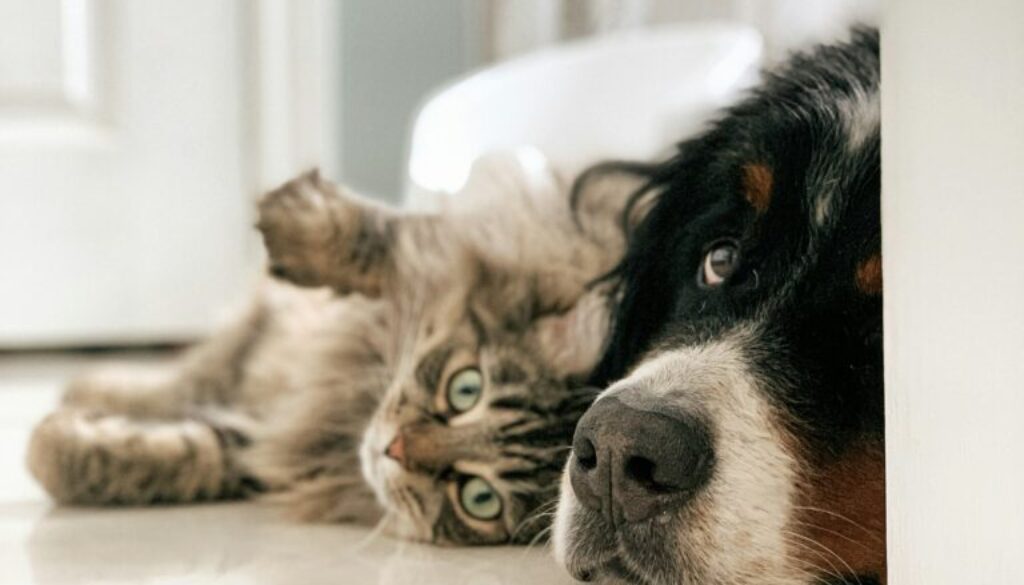The perils of plastics extend to our pets

By Aidan Charron
By now, you’d practically have to be living on Mars not to have heard about the health risks associated with plastics and the toxic chemical cocktail used to produce them.
Almost all plastics are derived from fossil fuels and have been found to contain over 16,000 chemicals, many of which are considered hazardous. Shockingly, despite evidence of harm, the US regulates only six percent of chemicals used to produce plastic, leaving potential health risks from most of the chemicals unchecked.
As plastics break down, they don’t disappear – they degrade into smaller pieces known as microplastics. When we eat, drink, or inhale microplastics, they leach plastic chemicals directly into our bodies.
To bring attention to these dangers, EARTHDAY.ORG released a report last November, Babies VS. Plastics, highlighting infants’ heightened plastics exposure and vulnerability to health risks. It makes for grim reading: microplastics and their additive chemicals are linked to interruptions in maternal-fetal communication, damaged DNA, attention deficit hyperactivity disorder (ADHD), autism, early onset puberty, and some forms of cancers.
Writing that report, I discovered that crawling on the floor puts babies at increased risk of inhaling microplastics in household dust. And since babies chew on everything, they are also more likely to ingest microplastics. The report made me wonder about my own plastics exposure, and about my two rescue dogs, Buzz and Sally. Since dogs and cats crawl on the floor and chew on everything their whole life span, are pets, like babies, especially vulnerable to microplastics?
To get some answers, in February I took a tox test for the two most prolific plastic chemicals in use, bisphenols and phthalates, which are both known to be dangerous to human health. The actress Amanda Seyfried, an EARTHDAY.ORG supporter and environmentalist, volunteered herself and her dog, Finn, to get tested too.
When the results finally came back after three months, everyone was in for a surprise.
While my phthalates exposure was low, my bisphenol levels were higher than 89% of all other test results in a national survey by the Centers for Disease Control and Prevention (CDC). Given all my efforts to avoid plastics, I was stunned. I don’t use single-use plastic bottles, I avoid nonstick cookware, and I never wear polyester, yet I still tested high for bisphenols.
Amanda and Finn’s results showed the opposite –they both tested low for bisphenols, but very high for phthalates.
The test results inspired me to do more digging into the hidden dangers our pets face from plastics in our homes, resulting in a new report, Pets Vs. Plastics, released this July.
The findings are enough to keep any pet parent up at night.
Just like the rest of us, research show pets are breathing in the plastic microfibers in household dust, which shed from our carpets, bedding and clothes. For example, studies have found high levels of plastic-related flame retardant chemicals (PBDEs), used on clothes and carpets, in the blood serum of dogs and cats.
Cats and dogs also ingest plastics. Cat food cans nearly all have a polyvinyl chloride (PVC)-based coating, while most dog food cans use a bisphenol coating. Both can leach into their food. Additionally, pet food can contain improperly removed plastic packaging from restaurant waste, as well the plastic ear tags from carcass heads.
While the research has just begun, plastic chemicals have already been associated with a variety of pet health issues, including potential infertility, liver and kidney damage and cancers.
It’s not just their food that is putting our pets at risk. 83% of dog owners give their pets inedible plastic toys, which can leach phthalates directly into their gums. This perhaps takes us to one of the most shocking revelations of all – according to the American Pet Products Association, (APPA), there are virtually no federal or state laws that apply expressly to the manufacture and sale of pet toys.
Manufacturers can make any claim they like about a pet toy, for example saying a plastic toy bone is “indestructible”. If your pet is unlucky enough to be hurt by this so-called “indestructible” toy, it’s not the toy manufacturer’s problem – it’s considered your fault.
And it’s not just the US – the global pet toy and accessory industry is essentially unregulated. After writing this report, it became clear to me that the safety of one billion pets worldwide, which support an industry set to be worth a staggering $500 billion by 2030, is not paramount.
Amanda is reviewing Finn’s food as she suspects that the packaging is the source of the phthalates. I have thrown out Sally Ride and Buzz’s plastic toys and I started cooking their meals for them because it is the only way I know they are not eating plastics. The dogs love it, of course, but it feels like I am having to go to extreme measures to keep them safe. Plus, I am aware that many dog owners won’t have this luxury.
It shouldn’t be on us to figure out how to protect our pets, our babies and ourselves from plastics. We need our political leaders to stand up to plastic producers and slash plastic production by 60% by 2040. Most importantly of all, we need the pet industry to be held accountable for not putting pet safety first. Until they are, pet owners need to be vigilant.
Aidan Charron is the Associate Global Director at EARTHDAY.ORG.
(Opinion columns published in The New Lede represent the views of the individual(s) authoring the columns and not necessarily the perspectives of TNL editors.)
(Featured image by Louis-Philippe Poitras on Unsplash.)
 EWG
EWG



August 2, 2024 @ 9:50 am
Thank you for revealing the hidden danger of plastics to people and pets. I am the caretaker of seven community cats and one of my own. I spend hundreds of dollars a month on pet food and medical care for them. How I can possibly switch to cooking their food at a substantially increased cost of money and time, I cannot begin to comprehend. Even reducing my own plastic intake seems next to impossible. You have given me much to think about, but I am not sure where to go to get workable solutions.
July 26, 2024 @ 10:03 am
It’s really shocking how few protections are in place for our pets, and ourselves, when it comes to microplastics and related toxic chemicals. We need to drastically reduce plastic production, particularly single use, and encourage innovation alternatives.
July 26, 2024 @ 9:31 am
I did not know any of this!!! How can the makers of these toys get away with this? How can they just make pet toys with LEAD and not be shut down????? Shocked and will be sharing widely. I am pretty annoyed but thank you for sharing this information as I for one shall be acting on. Plastic toys binned already!
July 26, 2024 @ 9:22 am
Great article, pet owners probably hav ezero idea how under regulated the pet industry is, it’s shocking.